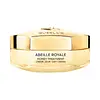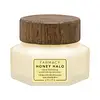What's inside
What's inside
 Key Ingredients
Key Ingredients

 Benefits
Benefits

 Concerns
Concerns

 Ingredients Side-by-side
Ingredients Side-by-side

Water
Skin ConditioningGlycerin
HumectantC15-19 Alkane
SolventSqualane
EmollientPropanediol
SolventJojoba Esters
EmollientGlyceryl Stearate
EmollientPEG-100 Stearate
Polyglycerin-3
HumectantC12-15 Alkyl Benzoate
AntimicrobialCellulose
AbsorbentCoco-Caprylate/Caprate
EmollientRoyal Jelly
Caprylyl Glycol
EmollientCetyl Alcohol
EmollientStearyl Alcohol
EmollientSteareth-21
CleansingAmmonium Acryloyldimethyltaurate/Vp Copolymer
Parfum
MaskingTribehenin
EmollientButyrospermum Parkii Butter
Skin ConditioningDimethicone
EmollientPhytosteryl/Octyldodecyl Lauroyl Glutamate
Skin ConditioningChlorphenesin
AntimicrobialMel
EmollientAcrylates/C10-30 Alkyl Acrylate Crosspolymer
Emulsion StabilisingTocopheryl Acetate
AntioxidantSodium Hyaluronate
HumectantXanthan Gum
EmulsifyingCeramide Ng
Skin ConditioningPEG-10 Phytosterol
EmulsifyingHydrogenated Olive Oil Unsaponifiables
EmollientSodium Hydroxide
BufferingLactic Acid
BufferingCI 77492
Cosmetic ColorantTocopherol
AntioxidantPalmitoyl Hexapeptide-12
Skin ConditioningGlycine Soja Oil
EmollientSilica
AbrasiveWater, Glycerin, C15-19 Alkane, Squalane, Propanediol, Jojoba Esters, Glyceryl Stearate, PEG-100 Stearate, Polyglycerin-3, C12-15 Alkyl Benzoate, Cellulose, Coco-Caprylate/Caprate, Royal Jelly, Caprylyl Glycol, Cetyl Alcohol, Stearyl Alcohol, Steareth-21, Ammonium Acryloyldimethyltaurate/Vp Copolymer, Parfum, Tribehenin, Butyrospermum Parkii Butter, Dimethicone, Phytosteryl/Octyldodecyl Lauroyl Glutamate, Chlorphenesin, Mel, Acrylates/C10-30 Alkyl Acrylate Crosspolymer, Tocopheryl Acetate, Sodium Hyaluronate, Xanthan Gum, Ceramide Ng, PEG-10 Phytosterol, Hydrogenated Olive Oil Unsaponifiables, Sodium Hydroxide, Lactic Acid, CI 77492, Tocopherol, Palmitoyl Hexapeptide-12, Glycine Soja Oil, Silica
Water
Skin ConditioningGlycerin
HumectantButyrospermum Parkii Butter
Skin ConditioningCaprylic/Capric Triglyceride
MaskingC13-15 Alkane
SolventCetearyl Alcohol
EmollientPentaerythrityl Tetraisostearate
Emollient1,2-Hexanediol
Skin ConditioningBis-Diglyceryl Polyacyladipate-1
EmollientDiisostearyl Malate
EmollientXylitylglucoside
HumectantHoney Extract
HumectantBetaine
HumectantPanthenol
Skin ConditioningHydrogenated Rapeseed Oil
EmollientHelianthus Annuus Seed Oil Unsaponifiables
EmollientCeramide NP
Skin ConditioningPropolis Extract
Skin ConditioningRoyal Jelly Extract
Skin ConditioningTocopherol
AntioxidantFicus Carica Fruit Extract
HumectantHippophae Rhamnoides Oil
EmollientGlucose
HumectantBisabolol
MaskingXylitol
HumectantAnhydroxylitol
HumectantCetearyl Glucoside
EmulsifyingTriolein
Skin ConditioningAcrylates/C10-30 Alkyl Acrylate Crosspolymer
Emulsion StabilisingHydroxyethyl Acrylate/Sodium Acryloyldimethyl Taurate Copolymer
Emulsion StabilisingArginine
MaskingAroma
Hydroxyacetophenone
AntioxidantXanthan Gum
EmulsifyingGlyceryl Dioleate
EmollientSodium Dilauramidoglutamide Lysine
HumectantSodium Phytate
Sorbitan Isostearate
EmulsifyingCitric Acid
BufferingPotassium Sorbate
PreservativeSodium Benzoate
MaskingWater, Glycerin, Butyrospermum Parkii Butter, Caprylic/Capric Triglyceride, C13-15 Alkane, Cetearyl Alcohol, Pentaerythrityl Tetraisostearate, 1,2-Hexanediol, Bis-Diglyceryl Polyacyladipate-1, Diisostearyl Malate, Xylitylglucoside, Honey Extract, Betaine, Panthenol, Hydrogenated Rapeseed Oil, Helianthus Annuus Seed Oil Unsaponifiables, Ceramide NP, Propolis Extract, Royal Jelly Extract, Tocopherol, Ficus Carica Fruit Extract, Hippophae Rhamnoides Oil, Glucose, Bisabolol, Xylitol, Anhydroxylitol, Cetearyl Glucoside, Triolein, Acrylates/C10-30 Alkyl Acrylate Crosspolymer, Hydroxyethyl Acrylate/Sodium Acryloyldimethyl Taurate Copolymer, Arginine, Aroma, Hydroxyacetophenone, Xanthan Gum, Glyceryl Dioleate, Sodium Dilauramidoglutamide Lysine, Sodium Phytate, Sorbitan Isostearate, Citric Acid, Potassium Sorbate, Sodium Benzoate
 Reviews
Reviews

Ingredients Explained
These ingredients are found in both products.
Ingredients higher up in an ingredient list are typically present in a larger amount.
Acrylates/C10-30 Alkyl Acrylate Crosspolymer is a synthetic polymer. It is used to thicken and improve the texture of products. Due to its properties, it can prevent water and oil ingredients from separating.
This ingredient is also known as shea butter. It is an effective skin hydrator and emollient.
Emollients help soothe and soften your skin. It does this by creating a protective film on your skin. This barrier helps trap moisture and keeps your skin hydrated. Emollients may be effective at treating dry or itchy skin.
Shea butter is rich in antioxidants. Antioxidants help fight free-radicals, or molecules that may harm the body. It is also full of fatty acids including stearic acid and linoleic acid. These acids help replenish the skin and keep skin moisturized.
While Shea Butter has an SPF rating of about 3-4, it is not a sunscreen replacement.
Shea butter may not be fungal acne safe. We recommend speaking with a professional if you have any concerns.
Learn more about Butyrospermum Parkii ButterGlycerin is already naturally found in your skin. It helps moisturize and protect your skin.
A study from 2016 found glycerin to be more effective as a humectant than AHAs and hyaluronic acid.
As a humectant, it helps the skin stay hydrated by pulling moisture to your skin. The low molecular weight of glycerin allows it to pull moisture into the deeper layers of your skin.
Hydrated skin improves your skin barrier; Your skin barrier helps protect against irritants and bacteria.
Glycerin has also been found to have antimicrobial and antiviral properties. Due to these properties, glycerin is often used in wound and burn treatments.
In cosmetics, glycerin is usually derived from plants such as soybean or palm. However, it can also be sourced from animals, such as tallow or animal fat.
This ingredient is organic, colorless, odorless, and non-toxic.
Glycerin is the name for this ingredient in American English. British English uses Glycerol/Glycerine.
Learn more about GlycerinTocopherol (also known as Vitamin E) is a common antioxidant used to help protect the skin from free-radicals and strengthen the skin barrier. It's also fat soluble - this means our skin is great at absorbing it.
Vitamin E also helps keep your natural skin lipids healthy. Your lipid skin barrier naturally consists of lipids, ceramides, and fatty acids. Vitamin E offers extra protection for your skin’s lipid barrier, keeping your skin healthy and nourished.
Another benefit is a bit of UV protection. Vitamin E helps reduce the damage caused by UVB rays. (It should not replace your sunscreen). Combining it with Vitamin C can decrease sunburned cells and hyperpigmentation after UV exposure.
You might have noticed Vitamin E + C often paired together. This is because it is great at stabilizing Vitamin C. Using the two together helps increase the effectiveness of both ingredients.
There are often claims that Vitamin E can reduce/prevent scarring, but these claims haven't been confirmed by scientific research.
Learn more about TocopherolWater. It's the most common cosmetic ingredient of all. You'll usually see it at the top of ingredient lists, meaning that it makes up the largest part of the product.
So why is it so popular? Water most often acts as a solvent - this means that it helps dissolve other ingredients into the formulation.
You'll also recognize water as that liquid we all need to stay alive. If you see this, drink a glass of water. Stay hydrated!
Learn more about WaterXanthan gum is used as a stabilizer and thickener within cosmetic products. It helps give products a sticky, thick feeling - preventing them from being too runny.
On the technical side of things, xanthan gum is a polysaccharide - a combination consisting of multiple sugar molecules bonded together.
Xanthan gum is a pretty common and great ingredient. It is a natural, non-toxic, non-irritating ingredient that is also commonly used in food products.
Learn more about Xanthan Gum